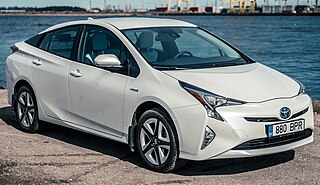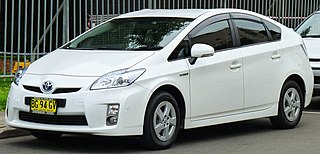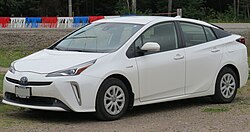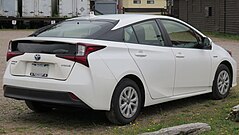
The Toyota Prius is a compact/small family liftback produced by Toyota. The Prius has a hybrid drivetrain, combined with an internal combustion engine and an electric motor. Initially offered as a four-door sedan, it has been produced only as a five-door liftback since 2003.

The Honda Insight is a hybrid electric vehicle that is manufactured and marketed by Honda. Its first generation was a two-door, two passenger liftback (1999–2006) and in its second generation was a four-door, five passenger liftback (2009–2014). In its third generation, it became a four-door sedan (2018–2022). It was Honda's first model with Integrated Motor Assist system and the most fuel efficient gasoline-powered car available in the U.S. without plug-in capability — for the length of its production run.

The Toyota Avalon is a full-size sedan produced by Toyota. It is Toyota's largest front-wheel drive sedan and serves as its flagship sedan in the United States, Canada, China and the Middle East. It was also produced in Australia from April 2000 until June 2005, when it was replaced in November 2006 by the Aurion. The first production Avalon rolled off the TMMK assembly line in Georgetown, Kentucky, in September 1994, and subsequent generations have all been manufactured at the Kentucky location to date.

The Ford Fusion Hybrid is a gasoline-electric hybrid powered version of the mid-sized Ford Fusion sedan manufactured and marketed by Ford, now in its second generation. A plug-in hybrid version, the Ford Fusion Energi, was released in the U.S. in February 2013.

The Ford C-Max is a car produced by the Ford Motor Company from 2003 to 2019. It has a five-door compact multi-purpose vehicle (MPV) design. The Ford Grand C-Max has a longer wheelbase.

The Toyota Sienna is a minivan manufactured and marketed by Toyota primarily for the North American market. It is named for the Italian city of Siena, in the region of Tuscany. It replaced the first generation Previa van in 1997 with a more conventional front-wheel drive layout and shares a heavily revised platform with the Camry. Both the Previa and original Sienna were smaller than the other minivans they competed against, but a redesign in 2003 increased the dimensions to match those of its competitors.

The Toyota Highlander, also known as the Toyota Kluger, is a mid-size crossover SUV with three-row seating produced by Toyota since 2000.

Miles per gallon gasoline equivalent is a measure of the average distance traveled per unit of energy consumed. MPGe is used by the United States Environmental Protection Agency (EPA) to compare energy consumption of alternative fuel vehicles, plug-in electric vehicles and other advanced technology vehicles with the energy consumption of conventional internal combustion vehicles rated in miles per U.S. gallon.

The Lexus HS is a dedicated hybrid vehicle introduced by Lexus as a new compact executive car sedan in 2009. Built on the Toyota New MC platform, it is classified as a compact under Japanese regulations concerning vehicle exterior dimensions and engine displacement. Unveiled at the North American International Auto Show in January 2009, the HS 250h went on sale in July 2009 in Japan, followed by the United States in August 2009 as a 2010 model. The HS 250h represented the first dedicated hybrid vehicle in the Lexus lineup, as well as the first offered with an inline-four gasoline engine. Bioplastic materials are used for the vehicle interior. With a total length of 4,700 mm (190 in), the Lexus HS is slightly larger than the Lexus IS, but still smaller than the mid-size Lexus ES.

The Toyota Prius Plug-in Hybrid is a plug-in hybrid liftback manufactured by Toyota. The first-generation model was produced from 2012 to 2016. The second-generation model has been produced since 2016. Production of the third-generation model began in 2023.

The third generation Toyota Prius debuted as a compact liftback manufactured and marketed by Toyota, having launched in 2009 for model year 2010 at the January 2009 North American International Auto Show. Internally designated as model XW30 and replacing the XW20 series, sales began in Japan on May 18, 2009.

The Toyota Prius is a full series-parallel hybrid electric compact car developed and manufactured by the Toyota Motor Corporation. The second generation Prius had been completely redesigned with a kammback profile. The XW20 series represented the second generation of the Toyota Prius, replacing its XW10 predecessor. The United States Environmental Protection Agency (EPA) and California Air Resources Board (CARB) rated the Prius as among the cleanest vehicles sold in the United States based on smog forming and toxic emissions in 2008. Toyota sold about 1,192,000 units of the second generation Prius worldwide.

The Toyota Prius (XW10) is a subcompact hybrid car that was produced by Toyota between 1997 and 2003 in Japan. The XW10 is divided into the NHW10 and its NHW11 counterpart, both of which represent the first generation of Prius series. The Toyota Prius is the first mass-produced hybrid car, and was released 2 years ahead of other manufacturers. While the NHW10 was available exclusively to Japan, it was subsequently introduced to worldwide markets in September 2000 with the NHW11. Toyota sold about 123,000 first generation Prius. Toyota's XW10 series Prius is notable as the first vehicle based on the Toyota MC platform.

The Toyota Priusv, also named Prius α in Japan, and Prius+ in Europe and Singapore, is a hybrid gasoline-electric automobile produced by Toyota introduced in Japan in May 2011, in the U.S. in October 2011, and released in Europe in June 2012. The Prius v was unveiled at the January 2011 North American International Auto Show alongside the Prius c Concept, and it is the first Prius variant to be spun off from the Prius platform. According to Toyota the "v" stands for "versatility". It is a compact MPV with a standard full hybrid drivetrain.

The Toyota Prius c (c stands for "city"), named the Toyota Aqua (Japanese: トヨタ・アクア, Hepburn: Toyota Akua) ("aqua" is Latin for water) in Japan, is a full hybrid gasoline-electric subcompact/supermini hatchback manufactured and marketed by Toyota. The Prius c is the third member of the Prius family, and combines the features of a Yaris-sized car with a hybrid powertrain. The Prius c is priced lower than the conventional Prius and has a higher fuel economy in city driving under United States Environmental Protection Agency test cycles. The Prius c was ranked by the EPA as the 2012 most fuel efficient compact car when plug-in electric vehicles are excluded.

The Toyota Camry (XV50) is a mid-size car produced by Toyota from August 2011 to August 2020. Replacing the XV40 series, the XV50 represents the seventh generation of the Toyota Camry in all markets outside Japan, which follows a different generational lineage.
The following table compares official EPA ratings for fuel economy for series production all-electric passenger vehicles rated by the EPA for model years 2015, 2016, 2017, and 2023 versus the model year 2016 vehicles that were rated the most efficient by the EPA with plug-in hybrid drivetrains, gasoline-electric hybrid drivetrains, and the average new vehicle for that model year, which has a fuel economy of 25 mpg‑US.
The following table compares EPA's estimated out-of-pocket fuel costs and fuel economy ratings of serial production plug-in hybrid electric vehicles rated by EPA as of January 2017 expressed in miles per gallon gasoline equivalent (mpg-e), versus the most fuel efficient gasoline-electric hybrid car, the 2016 Toyota Prius Eco, rated 56 mpg‑US, and EPA's average new 2016 vehicle, which has a fuel economy of 25 mpg‑US. The table also shows the fuel efficiency for plug-in hybrids in all-electric mode expressed as KWh/100 mile, the metric used by EPA to rate electric cars before November 2010.

The Hyundai Ioniq is a compact five-door liftback manufactured and marketed by Hyundai. The nameplate Ioniq is a portmanteau of ion and unique. It is marketed as the first automobile to be offered without a standard internal combustion engine, but rather sold in hybrid, plug-in hybrid, and all-electric variants.

The ninth generation Accord is a mid-size car introduced by Honda in 2012 which received a refreshed front fascia, grille, headlights, tail lights and alloy wheel designs for the 2016 model year. With the discontinuation of the smaller European and Japanese market Accord in 2015, the larger North American Accord became the only version in production, with the Hybrid version taking over as the flagship of Honda's automotive product in many markets that once received the smaller Accord.






















